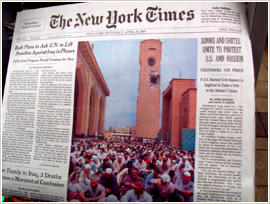
Long term I like this industry and this company. They have become much more efficient through the use of automation, accessed new markets through the use of rail and panamax vessels, and recognized that while rock is everywhere a new quarry or mine is very difficult to permit. No one wants to have blasting or rock trucks creating dust clouds near residential areas. So, if you already have the locations you have a valuable asset.
Company management has been very adept at telling Wall Street this story and backing up their thesis with significant, regular price increases that far exceeded covering any rising costs. The result has been dramatically increased net earnings and an expanding P/E ratio.
Generally I’m a buyer of stocks and tend to hold for long periods. In this instance I can’t buy the stock because it is significantly overvalued. Once again, MLM is an excellent company and one that I would gladly own, but at a lower entry price and I think I will see that more rational opportunity.
Why do I believe that MLM is/was priced too richly? Management has oversold the rock scarcity story and analysts have an average eps for 2008 of $7.76. Actual earnings for 2006 were $5.19 and the 2007 estimate is still $6.41.
The 2008 estimate is a 21% growth over ’07 and 52% over the ’06 results. I don’t think the last six months of 2007 will be good enough to earn $6.41 and the ’08 number is going to have to come way down. The economy isn’t cooperating and MLM needs a true “goldilocks” economy to come close to growing earnings by 20% again.
MLM’s business has three major components: residential, non-residential, and infrastructure. The fact that residential development has tanked is no secret. So far, in ’06 and interim ’07, the other two categories, plus price increases have allowed earnings to continue to grow in spite of the disaster in residential. On the last conference call the company noted that non-residential was flat, no longer growing and highway projects were being delayed. The CEO stayed by guidance and promised continued margin expansion. Zelnack, the CEO, sits on Beazer Homes board of directors so he isn’t unaware of the terrible housing situation. He remains confident.
However, on numerous occasions during the past 6 months, both he and SVP Sipling have sold large blocks of stock. While that isn’t normally a red flag, in these cases I believe it is. On multiple occasions, they exercised options that had 5-7 years of life left and elected to exercise, sell, and pay tax on millions early. You don’t see that very often, even near retirement. Buffett would advise that you should compound your money and delay paying your taxes till the last minute. Why sell millions of dollars worth of your stock early if you didn’t think the best of times were behind you. Not necessarily operating best of times, but irrational stock pricing best of times.
For years, this company has been run conservatively. With their recent pricing power they have garnered operating margins of 18% and a ROE of 24%. They’ve spent their cashflow to modernize and expand their facilities.
While not outright wild, the balance sheet has been leveraged up this year and debt now stands at $1.2B for a debt/equity ratio of 1.3:1. The proceeds of $500M borrowing during the last two quarters was used to retire stock. The company bought back over 3M shares for an average cost of $138 per share. So far, the current price is near $124, not a good use of cash other than juicing the eps number since less shares are outstanding. Interest expense will be rising also in the third quarter after the debt issuance.
In the past few days both TXI and EXP have reported their quarterly numbers. While the former is a major cement manufacturer and the latter is a wallboard leader, they both have divisions that sell aggregates and concrete so they are comparable to MLM. Volumes were down and pricing wasn’t robust like in prior quarters. They both have some operations in Texas, a big MLM market. Additionally RMIX, a concrete and aggregates operator, just pre-announced that they would miss analysts estimates and they too have a large Texas presence.
EXP reported that revenue for concrete and aggregates was down 11%! Operating profit was down 18% in that division. Concrete shipments were down 11% and aggregates shipments declined 20%! Rock pricing was up only 1% over third quarter ’06! while concrete managed to maintain 5% higher prices. The 18% operating profit decline is the troubling number.
TXI fared modestly better in aggregates and concrete. Aggregates revenue was down to 40 M from 43M in ’06. Concrete sales were 80M vs. 73M last year. Combined the division grew sales by 3%. TXI didn’t breakout operating profits so we can’t tell if costs grew by more or less than 3%.
Three somewhat similar companies and the results are not measurably better than the same quarter in 2006. Granted, these companies are not exactly comparable, but they do demonstrate that the residential decline is impacting the companies more than the non-residential and government work can compensate for. MLM is priced at a high P/E multiple and a huge Enterprise Value/EBITDA and that cannot continue if earnings aren’t growing at a robust clip.
VMC reports after the market closes on Monday and MLM announces before the open on Tuesday. Neither has pre-announced any shortfall for the third quarter. Whether they miss or hit expectations, the real important information will be available on the conference call. Future expectations and construction market conditions will be key to how well the share price behaves.
MLM could meet the analysts expectations of $2.04 for the quarter. Using TXI’s 3% sales growth produces Revenue of 622M.If they can maintain their 2nd quarter 29% gross profit they will have $180M to offset $39M in SGA, $18M interest, and $9M in inventory re-evaluation they won’t have this quarter. The company has announced that they will have a 2% lower tax accrual, 29%, so they could have net income of $85M. After the buybacks there are approximately 42M shares outstanding. The above scenario produces $2.02 eps vs. the Wall Street consensus of $2.04. But given the difficulty of RMIX, EXP, and TXI odds of a miss is significant.
While I think they may miss, I think they will likely guide lower or hedge somewhat which will cause concern. Current ’08 estimates are for a 21% increase in eps.You can’t be awarded with 20+ P/E if you aren’t growing earnings at a good clip, no matter how low bond rates are. There is virtually no residential development starting and significantly reduced housing starts so residential volumes are continuing to decline. Tighter credit standards are bleeding over into commercial construction and that will become noticeable as 2008 progresses. The public sector is still building, but even government bodies are showing “some” restraint in face of falling property values. Volumes will decline again in 2008 and I don’t think, after 2 years of out-sized price increases, that pricing will cover rising costs from here forward. Less business will cause competitors to become price sensitive to cover ongoing expenses and still make good money, although not as good as a public company will need to keep a high share price.
How have I played this investment? Not knowing when my thesis would prove correct, I purchased Jan’09 140 Puts. At MLM’s current $125 price I’m doing fine as I’ve been gaining “in the money” value faster than I’ve been losing “time value.” Obviously this can change quickly if results are as expected and the conference call is positive. The Fed could produce a big pop for MLM as well on Wednesday. The LEAP puts give me the luxury of time to continue to monitor the situation.
Now here’s something interesting. Within the past 6 months Goldman Sachs, an Egyptian billionaire, John Skully’s SPO, and, worst of all, highly respected, Ruane Cuniff have all taken very large, reportable positions in MLM. I’m confident, I’m crusty, and I’m keeping my position until I see something that changes my mind. But I wish it were 28 year old Harvard MBAs that had taken those big positions.
Come back for my interpretation of the VMC and MLM results.



















